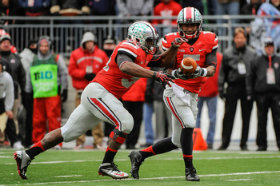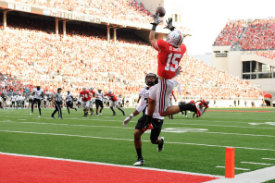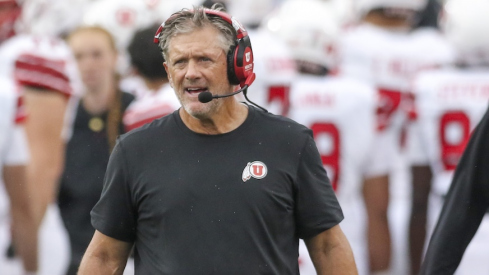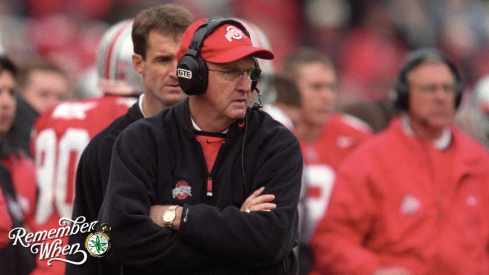One of the early returns of Football Study Hall's 2012 Charting Project has been its Anatomy of a Big Play analysis, which identified the common characteristics of 40+ yard plays from a representative sample of college football games last season.
 Reads formed the basis of many big plays in 2012
Reads formed the basis of many big plays in 2012For instance, of 213 big plays, a little over 60% came from one-back formations, approximately 67% were pass plays, and an overwhelming majority were out of the shotgun.
While Ohio State's offense improved drastically between 2011 and 2012, it did so by consistently moving the chains on longer drives than it did through big plays. The Buckeye offense ranked 41st in number of plays of 40 or more yards, with just 14 on the season.
Steady drives and ball control are undoubtedly important, but Meyer and Herman will certainly be looking to increase the number of touchdowns off of big plays in 2013.
The first thing that sticks out to me about these 14 big plays is the number that were against the worst defenses Ohio State faced on the season.
By my count, 10 of the 14 were against mediocre to terrible defenses – Indiana, Illinois, Cal, Miami, and Nebraska – and just four came against teams with quality defenses.
Some quick facts:
- All of Braxton's big gainers came on designed QB runs as opposed to scrambles
- 1/3 of the big passing plays were play action
- Only two players – Braxton Miller and Devin Smith – were consistent home run threats
- A little over half (8/14) of the big plays resulted in touchdowns
- A read was involved in seven of the 14 plays
Downs
| first | Second | Third | Fourth |
|---|---|---|---|
| 7 | 1 | 6 | 0 |
It shouldn't come as much of a surprise that the majority of big plays were on first or third down.
One potentially interesting finding is that of the six big plays that came on third downs, half of them were on third and four to go. This indicates that Herman was calling big plays when rushing for the first down was manageable. Instead, Ohio State would call a constraint play or play action – or a wrinkle off of a base play they had run earlier – to great effect.
Pass-Run Breakdown
The pass-to-run ratio was fairly close to the overall big play distribution (2:1) at 9:5.
Interestingly, of the five 40+ yard runs, all were by Braxton as opposed to one of the three blue-chip running backs on the roster. Braxton was clearly the home run threat in the ground game.
 Smith needs some company in the big play department
Smith needs some company in the big play departmentOffensive coordinators typically want two types of running threats on a team – the consistent four-yard gainer and the change of pace home run threat. The rise of the spread-to-run offense is responsible for reintroducing the possibility that the quarterback – and not just two different running backs – could be one of those two threats. Urban has varied which role his quarterback fills based upon personnel: Tebow was the consistent four-yard rusher on Urban's Florida teams, while his stable of Carlos Hyde, Rod Smith, and Bri'onte Dunn fills that role at Ohio State.
Based upon their 2013 recruiting efforts and 2014 offers, it is clear that Meyer and Herman want more backs capable of ripping off rushes of over 40 yards. On the one hand, Urban is recruiting hybrid players capable of switching between the backfield and slot receiver like Dontre Wilson, Jalin Marshall, and potentially James Clark.
However, what's more interesting is that the Ohio State staff is beginning to hone in on smaller and quicker running backs as well, like senior Jordan Hall, freshman Ezekiel Elliott, and redshirt freshman Warren Ball. As opposed to the Tresselian big, feature-back archetype (Beanie, Clarett, Pittman) I expect the staff to use a larger stable of more specialized backs in the future.
Big Play Receivers
| Devin Smith | Stoneburner | Rod Smith | Spencer | Corey Brown |
|---|---|---|---|---|
| 5 | 2 | 1 | 1 | 0 |
With just Stoneburner leaving out of the big-play receivers group and a host of big-time new freshmen coming in, wide receivers coach Zach Smith must be excited about the big-play potential for next year.
The receivers were one of the greenest groups on offense at the beginning of the season, but they did not lack for big plays. Devin Smith, who accounted for over half of the big receiving plays, became Braxton's go-to downfield threat.
The majority of these plays came on designed deep passes as opposed to short passes that were broken for big gains. This is of course where Jalin Marshall, Dontre Wilson, Elliott, James Clark, and (hopefully) Corey Brown have the potential to contribute immediately.
Corey Brown's role in spring practice will be one to watch; while he didn't have a single big play (though he did have several of around 30 yards) last season, he has the ability to play slot receiver and allow Devin Smith, sophomore Michael Thomas, and new JUCO signee Corey Smith to play the X and Y outside receiver positions.
Formations and Plays
| Empty Back | One back | Two Back |
|---|---|---|
| 6 | 6 | 2 |
Big plays were just as likely to come from empty-back sets as single-back/normal formations for Ohio State in 2012. This is much different than the "Anatomy of a Big Play" findings, which charted a 1:12:6 ratio between empty, one, and two-back formations.
This means that Ohio State was far more likely to get a big play out of an empty back set than the rest of the country. Devin Smith was the recipient of four of these big pass plays, usually on a "50X Follow" or four-verticals play. Both two-back set big plays were constraints off of base plays, with a triple option against Miami and a wheel route after initial an inverted veer look:
While each rushing play call was different, four of the five big runs were off of quarterback reads, with Braxton keeping the ball for big gains (3/5 were touchdowns). These plays included fake QB sweep counter trey, fake counter trey, inverted veer, zone read speed option, and a lead QB outside zone.
The Buckeyes jumped from 65th to 10th in offensive FEI rankings between 2011 and 2012, so the relative lack of 40+ yard plays can't be too concerning.
However, Meyer and Herman will certainly be looking for more big plays during spring practice. If 2012 is any indication, they can be found from no back sets, read-based constraint plays, and with Braxton's legs. Here's to 2013 adding some more film and fresh faces to the Buckeye highlight reel.

